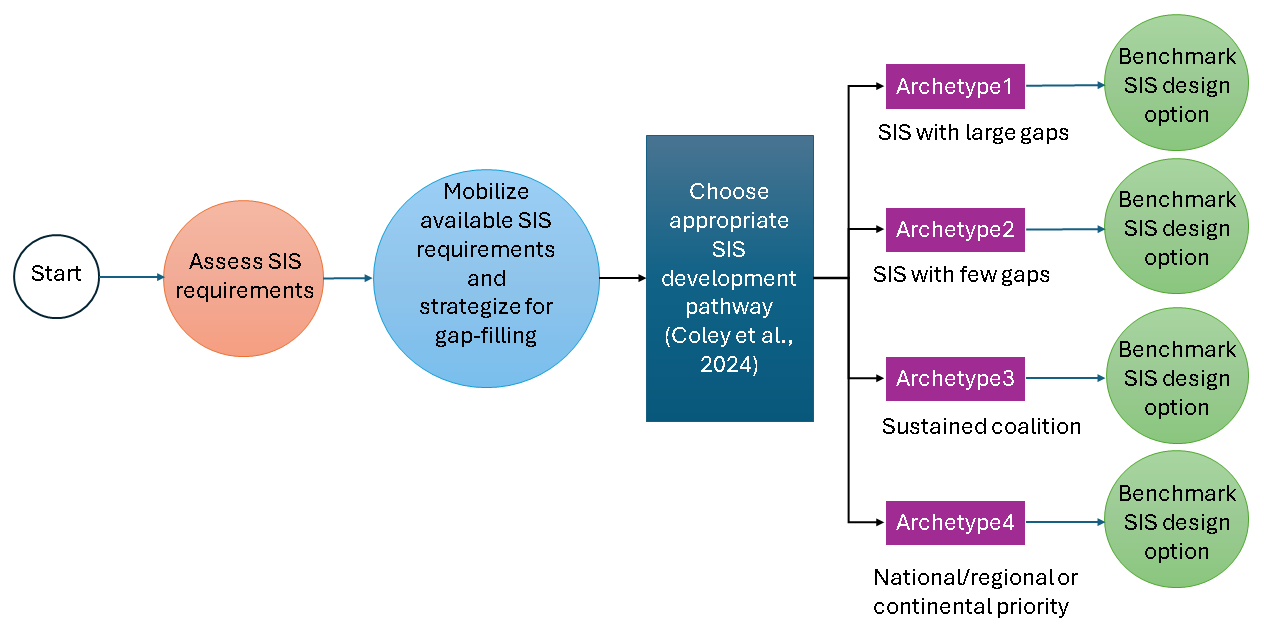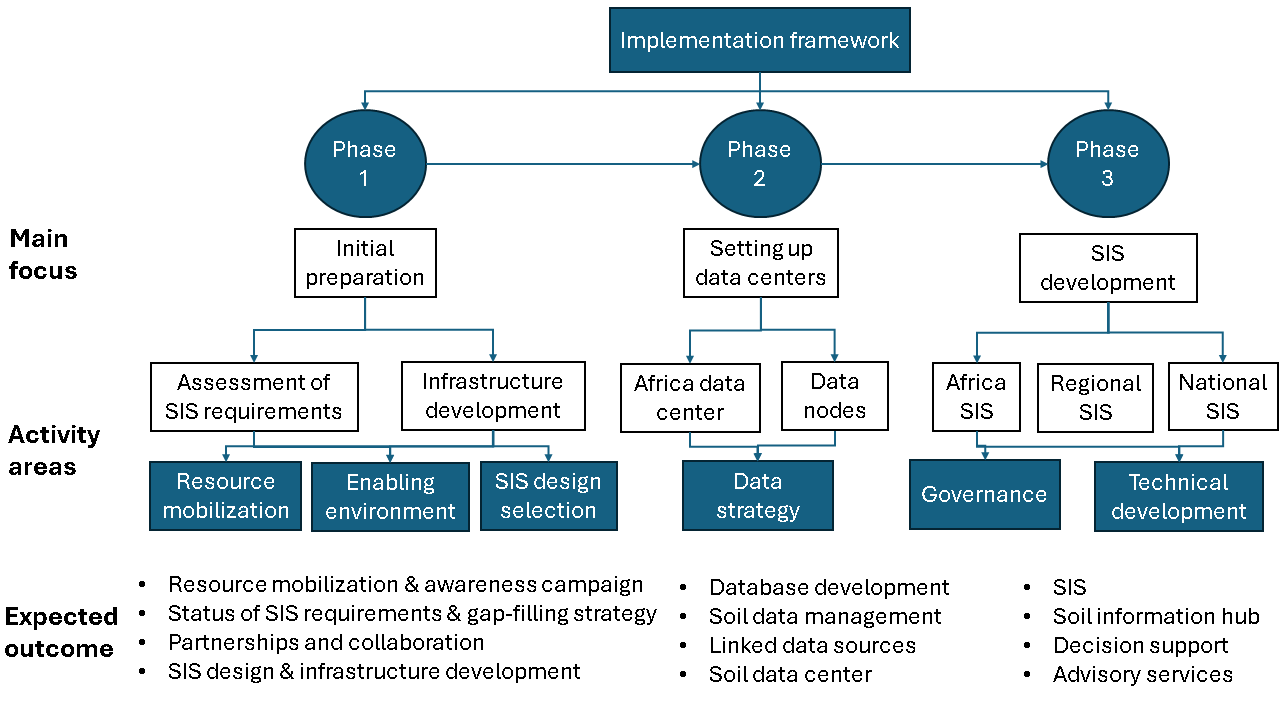4 How to get there: Implementation framework for SIS in Africa
4.1 Initial preparation
Initial preparation helps to set up appropriate plan for SIS implementation Figure 4.1. The first step in the planning is to assess the status of SIS requirements and outline availability and gaps on these requirements. SIS requirements were elaborated in Section Requirements for establishing soil information systems. The assessment will guide the strategy to mobilize and organize available SIS requirements and how to bridge the gap on what is missing or inadequate.

Figure 4.1: Initial preparation for SIS implementation
Assessment of SIS requirement also guides selection of the appropriate SIS development pathway. The literature shows four possible SIS development pathways (Coley et al. 2024):
- Archetype1: SIS without clearly targeted users and use-case and large gaps in SIS requirements
- Archetype2: SIS with clear target users and use-cases and a few gaps in SIS requirements.
- Archetype3: SIS sustained by a coalition of institutions/partners who pool up resources to overcome gaps in the SIS requirement. It’s also guided by identified and existing multisectoral users and use-cases.
- Archetype4: SIS developed as a core function of the governments or regional blocks or a continental body.
Existing SIS may be identified to benchmark the desired SIS, its development pathway and suitable design option from the Section on Design considerations for soil information systems for Africa.
4.2 Implementation framework
A phased implementation framework is proposed to progressively build the soil information systems in Africa. This approach was chosen because it allows tackling of some of the challenges which occur at certain stages of the SIS development. For example, analysis of SIS challenges in Section Challenges for soil information systems in Africa shows that most challenges in Africa were due to misconceptions at the initial stages of SIS development. These can be prioritized in the phased implementation framework. Furthermore, the framework is suitable where potential heavy demand for resources at certain SIS development stages may require innovation to manage the demand and resource allocation. Figure 4.2 outlines the framework, which focuses on building the resource portfolios, institutionalization of SIS, and choosing appropriate models for sustainable SIS.

Figure 4.2: Implementation framework
The strategy in phase 1 will focus on laying the foundation for sustainable SIS. It plans for the development of appropriate infrastructures onto which subsequent activities will be built such as infrastructure for resource mobilization, development of appropriate policies, and infrastructure for designing a suitable SIS. Infrastructure for resource mobilization will target both human and financial resources and will lead to the development of tools for mobilizing financial support, capacity development, institutionalization of SIS, establishment of agreements for collaboration with partners and stakeholders, and tools for tracking and reporting SIS progress. Infrastructure for enabling environment is very important for entrenching SIS into the government development programs among Africa Union member countries. In this regard, the infrastructure development is expected to give guidelines for appropriate policies and legislation towards sustainable management of SIS in Africa. The infrastructure for enabling environment will also be expected to develop appropriate tools for data and information sharing, contract agreements with service providers, and tools for customizing standards for data collection, processing, sharing, and information interpretation across the continent. Laying the foundation for appropriate SIS design will help harmonize inter-SIS data sharing and information exchange as well as communicating common soil message to all users and beneficiaries of soil data and information in Africa. SIS design can also include a systematic workflow for data organization, handling, and onboarding into the system. A standardized and uniform workflow will be beneficial to all SIS levels in Africa.
In phase 2, a stocktaking process is envisaged to review and analyze existing soil data for Africa, drawing from various open-access data sources such as national institutes, AfSIS and WoSIS, GSP, WOSSAC, iSDA, Soils4Africa, BGS and other repositories. The stocktaking process will identify data characteristics, gaps, ownership, copyrights and license terms, and standardization needs to inform the technical requirements for establishing data centers. A comprehensive data strategy should be developed, encompassing data policy, data quality, data modelling and organization, metadata management, data security, and data analytics. Phase 2 will lead to the development of data centers at the continental, regional, and national levels. The regional and national data centers will act as nodes for serving the continental data center.
Phases 3 will focus on establishing soil information systems with priority given to the continental SIS. Continental level SIS will not only set the standards for the lower-level SIS but will also support some countries who may need more time to build their SIS.
4.3 Indicator monitoring
The progress for development and implementation of SIS needs monitoring and trigger for actions to keep SIS on track. Although the framework for monitoring SIS progress will follow the procedures outlined in the SIA Framework (AU-FARA 2024) and the CAADP evaluation systems (https://www.nepad.org/caadp)(NEPAD 2003), a clear indicator set is needed to guide development of the SIS results framework. Table 4.1 proposes a potential indicator set which can be customized for monitoring SIS progress.| Main.activity | Milestone | Monitoring.indicator |
|---|---|---|
| Institutionalization of SIS | Establishment of NSIS governance | Number of permanent staff in NSIS leadership |
| National SIS policy and legislation | SIS policy or acts of parliament | |
| Annual budgetary allocation for SIS | % budgetary allocation for SIS | |
| Development of online SIS | Online SIS website and portal | Searchable online website for SIS |
| High resolution national soil information | % of agriculture land are mapped | |
| Advisory and decision support services | Available mobile/web apps for soil |